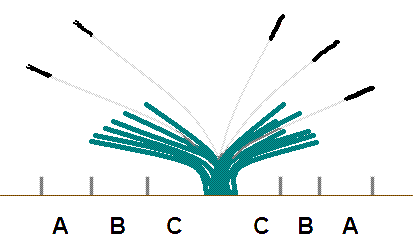Case StudiesGrass tussocks in arid SpainThe south-east of Spain is said to be the most arid part of Europe. Rainfall is low and summer temperatures may reach 50° Celsius for extended periods in some areas. In this region lichens (and bryophytes) exploit the protection offered by the larger grass tussocks, mostly Stipa tenacissima and Lygeum spartum. A group of Spanish researchers investigated the lichen and bryophyte communities growing with grass tussocks on gypsum-bearing soils in south-east Spain. These tussocks provide protection against direct sunlight and around their bases soil moisture will be held for longer since evaporation would be slower in the shade of the tussock. The area surrounding each tussock is not uniform and the research team distinguished three micro-habitat zones around each tussock. The following stylized diagram represents one tussock, with grey-green leaves and several flower spikes shown in grey and black. Moving inwards the first zone is represented by the letter A. The outer boundary corresponds roughly to the greatest reach of any part of the grass tussock and the inner boundary is marked roughly by the reach of the tussock leaves. In this area the shade varies considerably both during the day and through the year. There is a low level of organic material with a carbon/nitrogen ratio in the range 4.3-5.1. The soil is alkaline with the pH in the range 8.0-8.2 and the soil's electrical conductivity was 2.5-2.6 mmohs/cm. In zone B shade is permanent, though the leaf cover by the tussock is not complete. There is a higher organic soil content, with the carbon/nitrogen ratio in the range 12.4-13.5. The soil is alkaline, but less so than in A, with a pH of 7.8-7.9 and electrical conductivity around 2.6 mmohs/cm, much the same as that in zone A. Zone C is the area around the base of the tussock. Here the tussock cover is complete and shade is permanent. The carbon/nitrogen ratio was measured at about 15 to 16, indicating only slightly mineralized organic matter. The soil was slightly less alkaline than in B, the pH now being in the range 7.4-7.6 and electrical conductivity was in the range 2.1-2.3 mmohs/cm. The lichen and bryophyte community in A differs little from that of the fully exposed areas though, unlike the open areas, the shade in A favours Cladonia foliacea subspecies convoluta, much more common on the gypsum soils of north Spain. This Cladonia was not found in zones B or C. Also in zone A were Collema tenax, Diploschistes diacapis, Fulgensia fulgida, Fulgensia subbracteata, Psora crenata, Squamarina cartilaginea, Squamarina lentigera and Toninia sedifolia. This is a list of the species found in the A zones of all the tussocks sampled, but of course not all these species are necessarily found with every tussock and similar comments apply for species lists of the B and C zones. Lichen cover was rather sparse in the B zones and the following taxa were found there: Cladonia furcata subspecies subrangiformis, Collema tenax, Fulgensia subbracteata, Squamarina cartilaginea, Squamarina lentigera and Toninia sedifolia. The characteristic lichen of zone C was Lepraria crassisima var. isidiata, normally found on heavily shaded gypsum dust banks and Xanthoparmelia pokornyi and Psora albilabra, rarely found in arid areas, also grew in the C zone. Other taxa found in the C zone were: Buellia zoharyi, Catapyrenium rufescens, Collema tenax, Diploschistes diacapis, Diploschistes ocellatus var. almeriensis, Endocarponpusillum, Fulgensia desertorum, Fulgensia fulgida, Fulgensia subbracteata, Placynthium nigrum, Psora crenata, Psora decipiens, Psora saviczii, Squamarina cartilaginea, Squamarina lentigera and Toninia sedifolia. Reference
|
![An Australian Government Initiative [logo]](/images/austgovt_brown_90px.gif)


